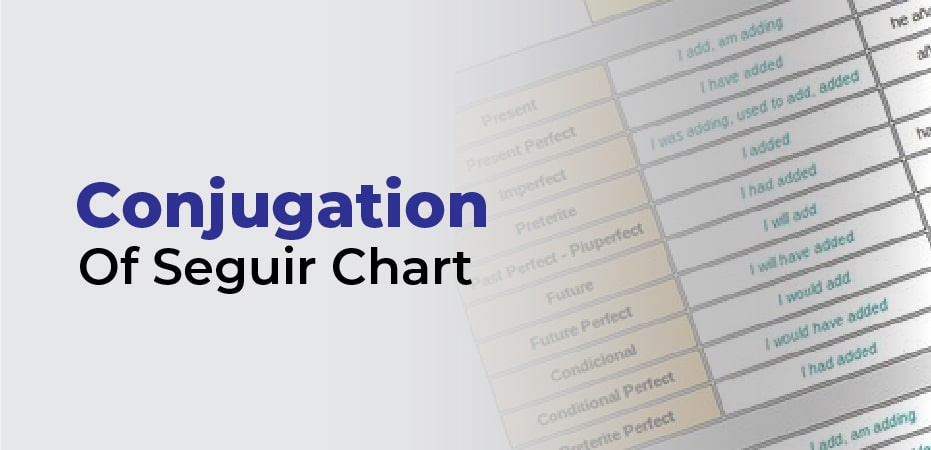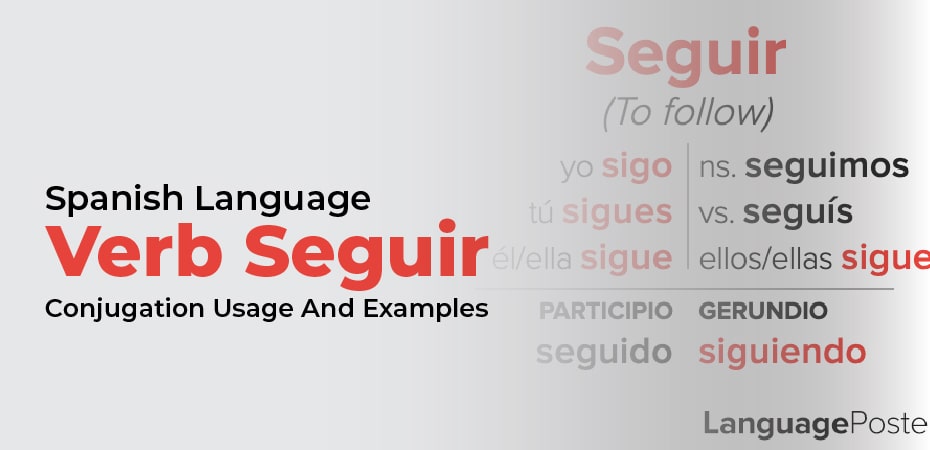Following or chasing, or continuing, is the common meaning of the Spanish verb seguir. Unlike other regular -ir verbs, follow follows a different conjugation pattern. There are only a few other verbs in the same conjugation pattern, such as getting (to get, attain, or achieve) and pursuing (to pursue, prosecute, or persecute). In contrast, there are verbs with similar conjugations as following, such as saying, dressing, and asking, where the e sometimes transforms into an “I”.
You will find examples and translations of the following conjugations. This includes verb conjugations in the indicative moods of the present, past and future, as well as the subjunctive and imperative moods.
When you were a kid, did you play follow the leader? Spanish is the language of following. We will learn how to conjugate the present and prêterite tenses of “continue.” You will also see examples of how the verb is used.
In the near future, Lupe and Mara will start new careers. Learning new things and following instructions are both challenging. Let’s listen to what they have to say about it.
My manager has always instructed me to follow his instructions in the new job I have. Whenever I go to work, I follow my manager’s instructions. In Spanish, seguir means “to follow.” This may also be translated as “to continue.” seguir means “to follow.”. This may also be translated as “to continue.”. Following means “to follow”. In this lesson you will learn how the verb follows is conjugated in the present and preterite tenses.

Conjugation Of Seguir Chart
Indicative conjugation
| Present | Preterite | Imperfect | Conditional | Future | |
| yo | sigo | seguí | seguía | seguiría | seguiré |
| tú | sigues | seguiste | seguías | seguirías | seguirás |
| él/ella/Ud. | sigue | siguió | seguía | seguiría | seguirá |
| nosotros | seguimos | seguimos | seguíamos | seguiríamos | seguiremos |
| vosotros | seguís | seguisteis | seguíais | seguiríais | seguiréis |
| ellos/ellas/Uds. | siguen | siguieron | seguían | seguirían | seguirán |
Subjunctive Conjugation
| Present | Imperfect | Imperfect 2 | Future | |
| yo | siga | siguiera | siguiese | siguiere |
| tú | sigas | siguieras | siguieses | siguieres |
| él/ella/Ud. | siga | siguiera | siguiese | siguiere |
| nosotros | sigamos | siguiéramos | siguiésemos | siguiéremos |
| vosotros | sigáis | siguierais | siguieseis | siguiereis |
| ellos/ellas/Uds. | sigan | siguieran | siguiesen | siguieren |
Imperative Conjugation
| Affirmative | Negative | |
| yo | – | – |
| tú | sigue | no sigas |
| Ud. | siga | no siga |
| nosotros | sigamos | no sigamos |
Continuous (Progressive) Conjugation
| Present | Preterite | Imperfect | Conditional | Future | |
| yo | estoy siguiendo | estuve siguiendo | estaba siguiendo | estaría siguiendo | estaré siguiendo |
| tú | estás siguiendo | estuviste siguiendo | estabas siguiendo | estarías siguiendo | estarás siguiendo |
| él/ella/Ud. | está siguiendo | estuvo siguiendo | estaba siguiendo | estaría siguiendo | estará siguiendo |
| nosotros | estamos siguiendo | estuvimos siguiendo | estábamos siguiendo | estaríamos siguiendo | estaremos siguiendo |
Perfect Tense
| Present | Preterite | Past | Conditional | Future | |
| yo | he seguido | hube seguido | había seguido | habría seguido | habré seguido |
| tú | has seguido | hubiste seguido | habías seguido | habrías seguido | habrás seguido |
| él/ella/Ud. | ha seguido | hubo seguido | había seguido | habría seguido | habrá seguido |
| nosotros | hemos seguido | hubimos seguido | habíamos seguido | habríamos seguido | habremos seguido |
Perfect Subjunctive Conjugation
| Present | Past | Future | |
| yo | haya seguido | hubiera seguido | hubiere seguido |
| tú | hayas seguido | hubieras seguido | hubieres seguido |
| él/ella/Ud. | haya seguido | hubiera seguido | hubiere seguido |
| nosotros | hayamos seguido | hubiéramos seguido | hubiéremos seguido |
| vosotros | hayáis seguido | hubierais seguido | hubiereis seguido |
| ellos/ellas/Uds. | hayan seguido | hubieran seguido | hubieren seguido |
Seguir Conjugation Preterite
Using the preterite tense, you talk about events that took place in the past. Following is a regular verb in the preterite. A shift of ‘i’ to ‘e’ for the third-person singular and plural occurs.
Seguir (Say-Gear) –To Follow And Continue
| SUBJECT PRONOUN |
PRETERITE TENSE | PRONUNCIATION | TRANSLATION |
| yo | seguí | seh-GEE | I followed/continued |
| tú | seguiste | seh-GEES-tay | You (informal) followed/continued |
| él, ella, usted |
siguió | see-gee-OH | He, she, you (formal) followed/continued |
| nosotros nosotras |
seguimos | seh-GHEE-mose | We followed/continued |
| vosotros vosotras |
seguisteis | seh-ghee-STAY-ees | You (plural, informal) followed/continued |
| ellos, ellas, ustedes |
siguieron | see-ghee-EH-rone | They (male, female), you (plural, informal) followed/continued |
Are there any stem changes for the follow?
Don’t cram for vocabulary or grammar.
| PRESENT | PRETERITE | |
| tú | has seguido | hubiste seguido |
| él/ella/Ud. | ha seguido | hubo seguido |
| nosotros | hemos seguido | hubimos seguido |
| vosotros | habéis seguido | hubisteis seguido |
Preterit Changes Stem?
A stem change in present tense -ar and -er verbs does not transfer to the preterite. The verbs are conjugated just as they are in the preterite. In the preterite, verbs without stem changes in the present tense don’t change in the same way.
| INGLÉS | YO | TÚ | ÉL/ELLA/USTED | NOSOTROS/-AS | VOSOTROS/-AS | ELLOS/ELLAS/USTEDES | |
| Present | I follow, am following | siga | sigas | siga | sigamos | sigáis | sigan |
| Present Perfect | I have followed, followed | haya seguido | hayas seguido | haya seguido | hayamos seguido | hayáis seguido | hayan seguido |
| Imperfect | I followed, was following | siguiera
OR siguiese |
siguieras
OR siguieses |
siguiera
OR siguiese |
siguiéramos
OR siguiésemos |
siguierais
OR siguieseis |
siguieran
OR siguiesen. |
| Past Perfect – Pluperfect | I had followed | hubiera seguido
OR hubiese seguido |
hubieras seguido
OR hubieses seguido |
hubiera seguido
OR hubiese seguido |
hubiéramos seguido
OR hubiésemos seguido |
hubierais seguido
OR hubieseis seguido |
hubieran seguido
OR hubiesen seguido. |
| Future | I will follow | siguiere | siguieres | siguiere | siguiéremos | siguiereis | siguieren |
| Future Perfect | I will have followed | hubiere seguido | hubieres seguido | hubiere seguido | hubiéremos seguido | hubiereis seguido | hubieren seguido |
Final Words
Congratulations for making it all the way to the end! If you have gotten to the end of the chapter, and you feel like you are making progress with your learning, then you are doing really well with your reading. You might want to practice some follow conjugations by going through the Cloze Collection provided at the end of this post if you’re up for it. There is a collection tailored specifically to what you learned from this lesson, in order for you to immediately begin to put what you have learned into practice.


